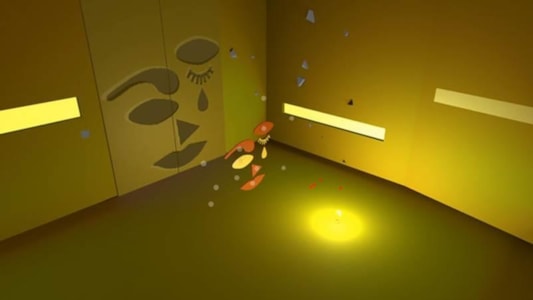On 24 April 2020, the Centre Pompidou is launching Prisme7, its first video game, which invites the public to discover some major works from the collection of the Musée national d’art moderne, and interact with them. Designed in association with Olivier Mauco of Game in Society and Abdel Bounane of Bright, Prisme7 immerses players aged 12 and over in a world of art and poetry.
Prisme7 is a fun yet educational platform game, freely available on mobiles (IOS/Android) and computers (PC/Mac), and has been designed for teenagers and adults seeking an insight into modern and contemporary creation. As they make their way between colour and light, players explore an organism that is constructed gradually as they discover the physical and sensory properties of the works of art. As they interact with Le Rhinocéros by Xavier Veilhan, New York City by Piet Mondrian, Andy Warhol’s Big Electric Chair or the famous “pipes” of the Centre Pompidou building imagined by Renzo Piano and Richard Rogers, players progress on their way through the game. After an initial introductory level (to familiarise themselves with the gameplay1), there are six game worlds where they can explore a selection of 40 iconic works from the Centre Pompidou collection, through the relationships between colour and function, colour and emotion or light and immersion. Prisme7 also immerses players in sound designed by Ircam Amplify, thus highlighting contemporary sound design creation. The character in Prisme7 is represented by an entity made up of molecules of light. This avatar was chosen out of a wish for neutrality and to move away from the traditional representations in the video-game industry (human, animal or hybrid figures), so that each player can identify themselves with it.
Prisme7 was designed thanks to funding from the “Éduthèque Innovative Digital Services” (SINÉ) call for projects of the Ministry for national education and youth, aiming to support innovative projects targeting teachers and pupils with the support of digital-sector start-ups and SMEs.
“And what if video games were also capable of playing with the rules of art and challenging their traditional values ? As game designers, we have sought to produce a contemporary work that fits into the history of art. After all, who plays around with
reality more than an artist does ? ”
Olivier Mauco, Game Director of Prisme 7, CEO of Game in Society and Co-Producer.
The player progresses around a number of different virtual worlds, collecting red orbs (that work like reservoirs of points) along their way. Various actions are proposed in relation to the salient features of the works (cast shadows, mirror image composition, etc.) to make the player more sensitive to artistic creation and allow a better understanding of the works.
As they progress through the different worlds, players also collect some works to compile their own personal virtual gallery.
“The video game is one of the most recent art forms in our culture, and yet paradoxically, no video game until now has ever succeeded in offering an artistic experience that immerses the player in the world of modern and contemporary art.”
Abdel Bounane, Creative Director of Prisme7, CEO of Bright and Co-Producer
Colour and Function
In a work, a colour may have its own function, its
own reference. On this level, each colour represents a specific function. The player must thus assign a
colour to the objects that don’t have one in order to continue.
Colour and Systems
In this level, which is divided into two visual systems, the player must group the colours together across the mirror, according to a principle of symmetry.
Colour and Activism
In this level resembling a large, dehumanised city, the inhabitants are a resource that allows the player to discover certain passages, and the city becomes a large mechanical system to be manipulated.
Colour and Emotion
A world without colour is a world that cannot exist. The player must colour every corner of this level to reveal its structure and reconstitute the environment.
Colour and Spirituality
The player walks through this colourful space where each zone must be activated using the correct object and colour. The player must match them in a way that goes beyond the symbolism of shapes and colour codes.
Light and Physics
Light can become a physical marker in space. The player uses their light to forge a path and access zones that were previously out of reach. The light casts shadows, and also creates paths that turn out to be very real !
Light and Immersion
Light can become one body with space. In this level, the player uses their light and their shadow. The movement of the player in the space will create unexpected forms that will eventually reveal, in a perfect layout, a shadow that turns out to be...
Your own work !
Guides to the works have been designed specially for Prisme7, with two levels of information (highlighting simple points first, followed by a detailed presentation) to provide users with information about the works of art. These guides are backed up by a variety of Centre Pompidou resources: podcasts, educational files and videos, etc.
Resources for all
Some of these resources have been created specifically for teachers.
The aim of providing complementary resources is to contribute to training and supporting teachers so that they can make good use of the game. Additional content is therefore available on the Eduthèque platform of the Ministry for national education and youth :
- for workshops and uses of the game in class have been devised to fit in with the curriculum for middle and high-schools, placing the emphasis on trans-disciplinary uses and opening up possibilities for innovative teaching practices, such as the “flipped classroom”1 .
- is provided to the preparatory storyboards for the video game, with the idea of showing the process of devising and designing the game.
- Tips are also provided to unlock certain levels of the game and go directly to a given sequence for a session of teaching.
Site: https://prisme7.io/
https://apps.apple.com/us/app/prisme-7/id1504092385?l=fr&ls=1
https://store.steampowered.com/app/1282500/Prisme_7/
https://play.google.com/store/apps/details?id=com.CentrePompidou.Prisme7
